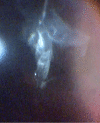Stickler Syndrome (SS): Laser Prophylaxis for Retinal Detachment (Modified Ora Secunda Cerclage, OSC/SS)
- PMID: 33447008
- PMCID: PMC7802593
- DOI: 10.2147/OPTH.S284441
Stickler Syndrome (SS): Laser Prophylaxis for Retinal Detachment (Modified Ora Secunda Cerclage, OSC/SS)
Abstract
Purpose: To introduce a novel technique of encircling laser prophylaxis (ora secunda cerclage Stickler syndrome, OSC/SS) to prevent rhegmatogenous retinal detachment (RRD) in Stickler syndrome eyes.
Patients and methods: After first eye RRD at age 50 and at age 18, respectively, a 53-year-old father and his 22-year-old son with type 2 SS (STL2) gave informed consent and underwent OSC/SS prophylaxis, performed in each fellow eye. A 26-year-old STL2 daughter then suffered first eye retinal detachment and similarly chose fellow eye OSC/SS prophylaxis. A second son, 28 years of age with STL2, chose OSC/SS prophylaxis in both eyes.
Results: The three OSC/SS treated fellow eyes have gone 12 years, 11 years, and 8 years without RRD. STL1 and less common STL2 eyes are known to have a similar rate of RRD, and 80% of STL1 fellow eyes develop RRD at a median of 4 years in the absence of prophylaxis. Moreover, five of six (83%) known STL2 family members suffered RRD, only the STL2 son with bilateral OSC/SS remaining bilaterally attached. All five OSC/SS treated eyes (average 8.7 years post-prophylaxis) retained preoperative visual acuity of 20/20 to 20/30, with an average, asymptomatic reduction of meridional field in each eye to 50 degrees. In contrast, in the three eyes having suffered RRD prior to presentation, visual acuity ranged from 20/125 to 8/200 and average meridional field was 29 degrees.
Conclusion: Encircling grid laser (OSC) modified in Stickler eyes to encompass the ora serrata and extend posteriorly to and between the vortex vein ampullae (OSC/SS) is a reasonable RRD prophylaxis option to offer STL1 and STL2 patients as an alternative to no treatment or less effective prophylaxis. Because of rarity and severity, the ultimate proof of safety and efficacy will likely come not from randomized trials, but from a non-randomized, prospective, cohort comparison study of such individual efforts.
Keywords: OSC; OSC/SS; Ora Secunda Cerclage; SS; STL1; STL2; Stickler syndrome; encircling laser prophylaxis; giant retinal tear; retinal detachment prevention.
© 2021 Morris et al.
Conflict of interest statement
The authors report no conflicts of interest in this work financial or otherwise.
Figures










References
-
- Robin NH, Moran RT, Warman M, et al. Stickler syndrome In: Pagon RA, Adam MP, Bird TD, editors. GeneReviews. Seattle: University of Washington, Seattle; 2017.
Publication types
LinkOut - more resources
Full Text Sources
Other Literature Sources
Medical

